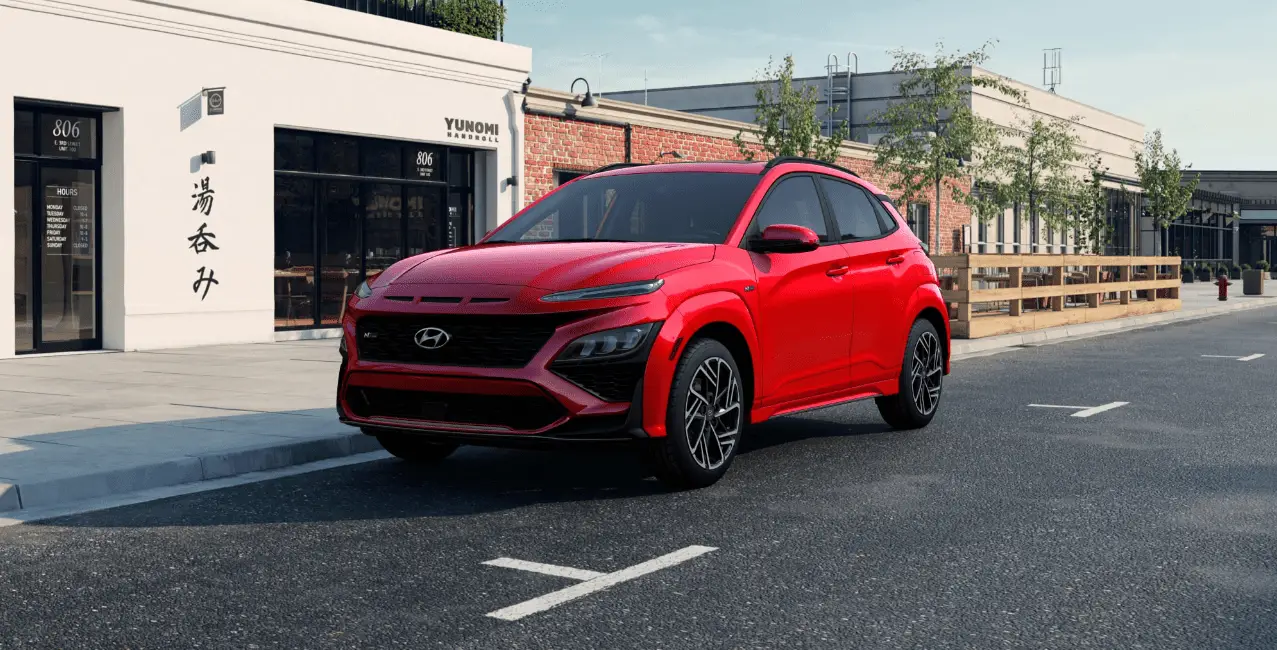Hyundai Kona 2023 Important Safety Precautions
Hyundai’s dedication to passenger safety is exemplified by the 2023 Hyundai Kona Safety Precautions, Seats, and Seat Belts Guidelines. This extensive manual acts as a barrier of defense, highlighting how crucial safety is in the Kona. It offers crucial information on how to use seat belts correctly, choose the right seating arrangements, and take safety procedures to keep passengers safe and comfortable on their travels. Hyundai equips drivers and passengers with the knowledge to make every ride in the Kona safe and worry-free by providing comprehensive instructions on how to choose the safest seating positions, secure child safety seats, and use seat belts effectively. This embodies the brand’s commitment to passenger well-being and vehicular excellence.
2023 Hyundai KONA Specs, Price, Features, Milage (Brochure)
Important Safety Precautions
You will find many safety precautions and recommendations throughout this section, and throughout this manual. The safety precautions in this section are among the most important.
Always Wear Your Seat Belt
A seat belt is your best protection in all types of accidents. Airbags are designed to supplement seat belts, not replace them. So even though your vehicle is equipped with air bags, ALWAYS make sure you and your passengers wear your seat belts and wear them properly.
Restrain All Children
All children under age 13 should ride in your vehicle properly restrained in the rear seat, not the front seat. Infants and small children should be restrained in an appropriate child restraint. Larger children should use a booster seat with the lap/shoulder belt until they can use the seat belt properly without a booster seat.
Air Bag Hazards
While airbags can save lives, they can also cause serious or fatal injuries to occupants who sit too close to them, or who are not properly restrained. Infants, young children, and shorter adults are at the greatest risk of being injured by an inflating airbag. Follow all instructions and warnings in this manual.
Driver Distraction
Driver distraction presents a serious and potentially deadly danger, especially for inexperienced drivers. Safety should be the first concern when behind the wheel, and drivers need to be aware of the wide array of potential distractions, such as drowsiness, reaching for objects, eating, personal grooming, other passengers, and using cellular phones.
Drivers can become distracted when they take their eyes and attention off the road or their hands off the wheel to focus on activities other than driving. To reduce your risk of distraction or getting into an accident:
- ALWAYS set up your mobile devices (for example, MP3 players, phones, navigation units, etc.) when your vehicle is parked or safely stopped.
- ONLY use your mobile device when allowed by laws and when conditions permit safe use. NEVER text or email while driving. Most states have laws prohibiting drivers from texting. Some states and cities also prohibit drivers from using handheld phones.
- NEVER let the use of a mobile device distract you from driving. You have a responsibility to your passengers and others on the road to always drive safely, with your hands on the wheel as well as your eyes and attention on the road.
Control Your Speed
Excessive speed is a major factor in crash injuries and deaths. Generally, the higher the speed, the greater the risk, but serious injuries can also occur at lower speeds. Never drive faster than is safe for current conditions, regardless of the maximum speed posted.
Keep Your Vehicle in Safe Condition
Having a tire blowout or a mechanical failure can be extremely hazardous. To reduce the possibility of such problems, check your tire pressures and condition frequently, and perform all regularly scheduled maintenance.
Hyundai Kona 2023 Seats and Seat Belts
Seats

The actual layout of the vehicle may differ from the illustration
Driver’s seat
- Forward and rearward
- Seatback angle
- Seat cushion height
- Seat cushion angle
- Lumbar support
Front passenger’s seat
- Forward and rearward
- Seatback angle
Safety Precautions
Adjusting the seats so that you are sitting in a safe, comfortable position plays an important role in driver and passenger safety together with the seat belts and air bags in an accident.
WARNING
Do not use a cushion that reduces friction between the seat and the passenger. The passenger’s hips may slide under the lap portion of the seat belt during an accident or a sudden stop. Serious or fatal internal injuries could result because the seat belt cannot operate properly.
Airbags
You can take steps to reduce the risk of being injured by an inflating airbag. Sitting too close to an airbag greatly increases the risk of injury in the event the airbag inflates. The National Highway Traffic Safety Administration (NHTSA) recommends that drivers allow at least 10 inches (25 cm) between the center of the steering wheel and their chest.
WARNING
To reduce the risk of serious injury or death from an inflating airbag, take the following precautions:
- Adjust the driver’s seat as far to the rear as possible while maintaining the ability to maintain full control of the vehicle.
- Adjust the front passenger seat as far to the rear as possible.
- Hold the steering wheel by the rim with your hands at the 9 o’clock and 3 o’clock positions to minimize the risk of injuries to your hands and arms.
- NEVER place anything or anyone between the steering wheel and the airbag.
- Do not allow the front passenger to place feet or legs on the dashboard to minimize the risk of leg injuries.
Seat belts
Always fasten your seat belt before starting any trip.
At all times, passengers should sit upright and be properly restrained. Infants and small children must be restrained in appropriate child restraint systems. Adults and children who have outgrown a booster seat must be restrained using the seat belts.
WARNING
Take the following precautions when adjusting your seat belt:
- NEVER use one seat belt for more than one occupant.
- Always position the seatback upright with the lap portion of the seat belt snug and low across the hips.
- NEVER allow children or small infants to ride on a passenger’s lap.
- Do not route the seat belt across your neck, across sharp edges, or reroute the shoulder strap away from your body.
- Do not allow the seat belt to become caught or jammed.
Front Seats
WARNING
Take the following precautions when adjusting your seat:
- NEVER attempt to adjust the seat while the vehicle is moving. The seat could respond with unexpected movement and may cause loss of vehicle control resulting in an accident.
- Do not place anything under the front seats. Loose objects in the driver’s foot area could interfere with the operation of the foot pedals, causing an accident.
- Do not allow anything to interfere with the normal position and proper locking of the seatback.
- Do not place a cigarette lighter on the floor or seat. When you operate the seat, gas may exit out of the lighter causing a fire.
- Use extreme caution when picking up small objects trapped under the seats or between the seat and the center console. Your hands might be cut or injured by the sharp edges of the seat mechanism.
- If there are occupants in the rear seats, be careful while adjusting the front seat position.
- Make sure that the seat is locked in place after the adjustment. If not, the seat might move unexpectedly resulting in an accident.
CAUTION
To prevent injury:
- Do not adjust your seat while wearing your seat belt. Moving the seat cushion forward may cause strong pressure on your abdomen.
- Do not allow your hands or fingers to get caught in the seat mechanisms while the seat is moving.
Manual adjustment (if equipped)
The front seat can be adjusted by using the levers located on the outside of the seat cushion. Before driving, adjust the seat to the proper position so that you can easily control the steering wheel, foot pedals and controls on the instrument panel.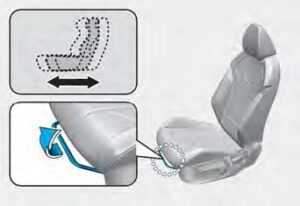
Forward and rearward adjustment
To move the seat forward or rearward:
- Pull up the seat slide adjustment lever and hold it.
- Slide the seat to the position you desire.
- Release the lever and make sure the seat is locked in place. Move forward and rearward without using the lever. If the seat moves, it is not locked properly.
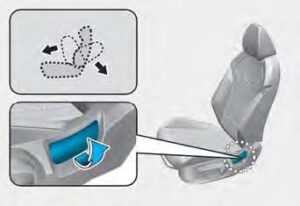
Seatback angle
To recline the seatback:
- Lean forward slightly and lift up the seatback lever.
- Carefully lean back on the seat and adjust the seat back to the position you desire.
- Release the lever and make sure the seatback is locked in place. (The lever MUST return to its original position for the seatback to lock.)
Reclining seatback
Sitting in a reclined position when the vehicle is in motion can be dangerous. Even when buckled up, the protection of your restraint system (seat belts and airbags) is greatly reduced by reclining your seatback.
WARNING
NEVER ride with a reclined seatback when the vehicle is moving. Riding with a reclined seatback increases your chance of serious or fatal injuries in the event of a collision or sudden stop. Drivers and passengers should ALWAYS sit well back in their seats, properly belted, and with the seatbacks upright.
Seat belts must be snug against your hips and chest to work properly. When the seatback is reclined, the shoulder belt cannot do its job because it will not be snug against your chest. Instead, it will be in front of you. During an accident, you could be thrown into the seat belt, causing neck or other injuries.
The more the seatback is reclined, the greater the chance the passenger’s hips will slide under the lap belt or the passenger’s neck will strike the shoulder belt.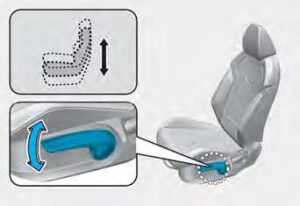
Seat cushion height (for driver’s seat, if equipped)
To change the height of the seat cushion:
- Push down on the lever several times, to lower the seat cushion.
- Pull up on the lever several times, to raise the seat cushion.
Power adjustment (if equipped)
The front seat can be adjusted by using the control switches located on the outside of the seat cushion. Before driving, adjust the seat to the proper position so that you can easily control the steering wheel, foot pedals, and controls on the instrument panel.
WARNING
NEVER allow children in the vehicle unattended. The power seats are operable when the vehicle is turned off.
NOTICE
To prevent damage to the seats:
- Always stop adjusting the seats when the seat has moved as far forward or rearward as possible.
- Do not adjust the seats for longer than necessary when the vehicle is turned off. This may result in unnecessary battery drain.
- Do not operate two or more seats at the same time. This may result in an electrical malfunction.
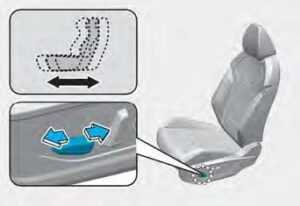
Forward and rearward adjustment
To move the seat forward or rearward:
- Push the control switch forward or rearward.
- Release the switch once the seat reaches the desired position.
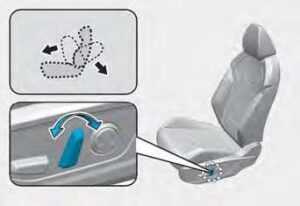
Seatback angle
To adjust the seatback:
- Rotate the top of the control switch forward or rearward.
- Release the switch once the seatback reaches the desired position.
Reclining seatback
Sitting in a reclined position when the vehicle is in motion can be dangerous. Even when buckled up, the protection of your restraint system (seat belts and airbags) is greatly reduced by reclining your seatback.
WARNING
NEVER ride with a reclined seatback when the vehicle is moving. Riding with a reclined seatback increases your chance of serious or fatal injuries in the event of a collision or sudden stop. Driver and passengers should always sit well back in their seats with the seatbacks upright and should be belted properly. Seat belts must be snug against your hips and chest to work properly. When the seatback is reclined, the shoulder belt cannot do its job because it will not be snug against your chest. Instead, it will be in front of you. During an accident, you could be thrown into the seat belt, causing neck or other injuries. The more the seatback is reclined, the greater the chance the passenger’s hips will slide under the lap belt or the passenger’s neck will strike the shoulder belt.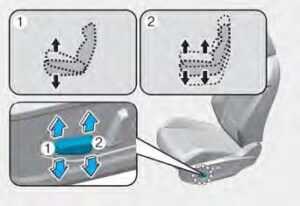
Seat cushion tilt (1) (if equipped)
To change the angle of the front part of the seat cushion: Push the front portion of the control switch up to raise or down to lower the front part of the seat cushion. Release the switch once the seat reaches the desired position.
Seat cushion height (2) (if equipped)
To change the height of the seat cushion: Push the rear portion of the control switch up to raise or down to lower the height of the seat cushion. Release the switch once the seat reaches the desired position. 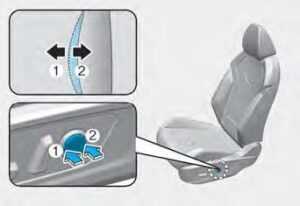
Lumbar support (for driver’s seat, if equipped)
The lumbar support can be adjusted by pressing the lumbar support switch. Press the front portion of the switch (1) to increase support or the rear portion of the switch (2) to decrease support.
Seatback pocket (if equipped)
The seatback pocket is provided on the back of the front seatbacks.
WARNING
To prevent the Occupant Classification System from malfunctioning:
Do not hang onto the front passenger’s seatback.
CAUTION
Do not put heavy or sharp objects in the seatback pockets. In an accident, they could come loose from the pocket and injure occupants.
Rear Seats
Folding the rear seat (if equipped)
The rear seatbacks can be folded to facilitate carrying long items or to increase the luggage capacity of the vehicle.
WARNING
Never allow passengers to sit on top of the folded-down seatback while the vehicle is moving. This is not a proper seating position and no seat belts are available for use. This could result in serious injury or death in case of an accident or sudden stop. Objects carried on the folded-down seatback should not extend higher than the top of the front seatback. This could allow cargo to slide forward and cause injury or damage during sudden stops.
To fold down the rear seatback:
- Set the front seatback to the upright position and if necessary, slide the front seat forward.
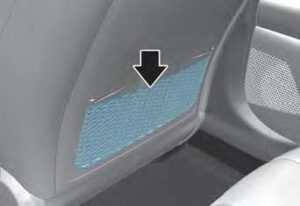
- Lower the rear head restraints to the lowest position by pushing and holding the release button and pushing down on the head restraint.

- Pull on the seatback folding lever located in the trunk.
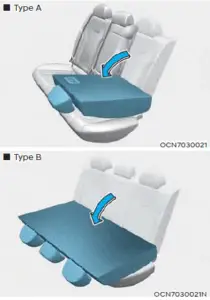
- Fold the seatback toward the front of the vehicle.
- To use the rear seat, lift and pull the seat back rearward. Pull the seatback firmly until it clicks into place. Make sure the seatback is locked in place.
WARNING
When returning the rear seatback from a folded to an upright position, hold the seatback and return it slowly. Ensure that the seatback is completely locked into its upright position by pushing on the top of the seatback. In an accident or sudden stop, an unlocked seatback could allow cargo to move forward with great force and enter the passenger compartment, which could result in serious injury or death.
WARNING
Do not place objects in the rear seats, since they cannot be properly secured and may hit vehicle occupants in a collision causing serious injury or death.
WARNING
Make sure the vehicle is off, the shift lever is in P (Park), and the parking brake is securely applied whenever loading or unloading cargo. Failure to take these steps may allow the vehicle to move if the shift lever is inadvertently moved to another position.
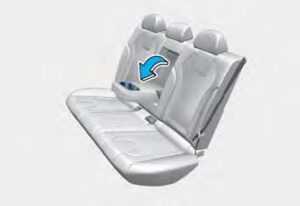
The armrest is located in the center of the rear seat. Pull the armrest down from the seatback to use it.
Head Restraints
The vehicle’s front and rear seats
have adjustable head restraints. The head restraints provide comfort for passengers, but more importantly, they are designed to help protect passengers from whiplash and other neck and spinal injuries during an accident, especially in a rear-impact collision.
WARNING
To help reduce the risk of serious injury or death in an accident, take the following precautions when adjusting your head restraints:
- Always properly adjust the head restraints for all passengers BEFORE starting the vehicle.
- NEVER let anyone ride in a seat with the head restraints removed or reversed.

- Adjust the head restraints so the middle of the head restraint is at the same height as the height of the top of the eyes.
- NEVER adjust the head restraint position of the driver’s seat when the vehicle is in motion.
- Adjust the head restraint as close to the passenger’s head as possible. Do not use a seat cushion that holds the body away from the seatback.
- Make sure the head restraint locks into position after adjusting it.
NOTICE
To prevent damage, NEVER hit or pull on the head restraints.
CAUTION
When there are no occupants in the rear seats, adjust the height of the head restraint to the lowest position. The rear seat head restraint can reduce the visibility of the rear area.
Front seat head restraints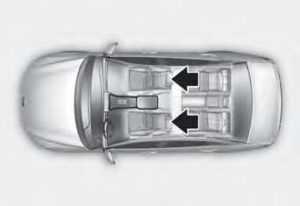
Both the driver’s and passenger’s front seats are equipped with adjustable head restraints for safety and comfort.
Adjusting the height up and down
To raise the head restraint:
- Pull it up to the desired position (1).
To lower the head restraint:
- Push and hold the release button (2) on the head restraint support.
- Lower the head restraint to the desired position (3).

Forward and rearward adjustment (if equipped) The head restraint can be adjusted forward to 3 different positions by pulling the head restraint forward to the desired detent. To adjust the head restraint to it’s furthest rearwards position, pull it fully forward to the farthest position and release it.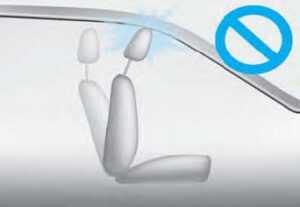
NOTICE
If you recline the seatback towards the front with the head restraint and seat cushion raised, the head restraint may come in contact with the supervisor or other parts of the vehicle.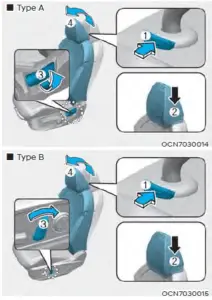
Removal/Reinstallation
To remove the head restraint:
- Recline the seatback (2) rearward using the seatback angle lever (1).
- Raise the head restraint as far as it can go.
- Press the head restraint release button (3) while pulling the head restraint up (4).
WARNING
NEVER allow anyone to travel in a seat with the head restraint removed.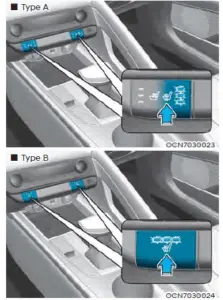 To reinstall the head restraint:
To reinstall the head restraint:
- Put the head restraint poles (2) into the holes while pressing the release button (1).
- Adjust the head restraint to the appropriate height.
- Adjust the seatback (4) forward using the seatback angle lever (3).
WARNING
Always make sure the head restraint locks into position after reinstalling and adjusting it properly.
Rear seat head restraints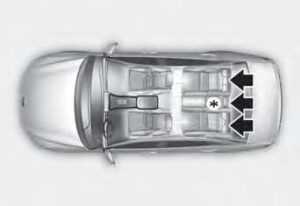
The rear seats are equipped with head restraints in all the seating positions for the passenger’s safety and comfort.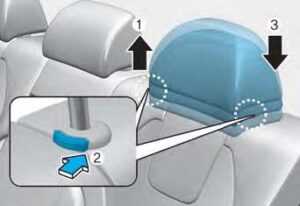
Adjusting the height up and down (if equipped)
To raise the head restraint:
- Pull it up to the desired position (1).
To lower the head restraint:
- Push and hold the release button (2) on the head restraint support.
- Lower the head restraint to the desired position (3).
Seat Warmers (if equipped)
Front seat warmers
Seat warmers are provided to warm the seats during cold weather.
WARNING
The seat warmers can cause a SERIOUS BURN, even at low temperatures and especially if used for long periods of time. Passengers must be able to feel if the seat is becoming too warm so they can turn it off, if needed.
People who cannot detect temperature change or pain to the skin should use extreme caution, especially the following types of passengers:
- Infants, children, elderly or disabled persons, or hospital outpatients.
- People with sensitive skin or who burn easily.
- Fatigued individuals.
- Intoxicated individuals.
- People taking medication that can cause drowsiness or sleepiness.
WARNING
NEVER place anything on the seat that insulates against heat when the seat warmer is in operation, such as a blanket or seat cushion. This may cause the seat warmer to overheat, causing a burn or damage to the seat.
NOTICE
To prevent damage to the seat warmers and seats:
- Never use a solvent such as paint thinner, benzene, alcohol or gasoline to clean the seats.
- Do not place heavy or sharp objects on seats equipped with seat warmers. may damage the seat warmer or air ventilation system.
- Do not change the seat cover. It may damage the seat warmer or air ventilation system.

While the engine is running, push either of the switches to warm the driver’s seat or the front passenger’s seat. During mild weather or under conditions where the operation of the seat warmer is not needed, keep the switches in the OFF position.
- Manual temperature control Each time you push the switch, the temperature setting of the seat is changed as follows:
- Front seat
- Automatic temperature control The seat warmer starts to automatically control the seat temperature in order to prevent low-temperature burns after being manually turned ON.
You may manually press the switch to increase seat temperature. However, it soon returns the automatic mode again.
- When pressing the switch for more than 1.5 seconds with the seat warmer operating, the seat warmer will turn OFF.
- The seat warmer defaults to the OFF position whenever the ignition switch is in the ON position. However, if the Auto Comfort Control function is ON, the driver’s seat warmer will turn on and off depending on the ambient temperature.
- Auto Comfort Control (for driver’s seat, if equipped)
- The seat warmer automatically controls the seat temperature depending on the ambient temperature when the engine is running. If the seat warmer switch is pushed, the seat warmer will have to be controlled manually. To use this function, it must be activated from the Settings menu in the AVN system screen. For more details, refer to the separately supplied Car Infotainment System manual.
Air Ventilation Seat (if equipped)
Front air ventilation seat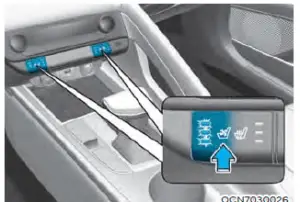
The air ventilation seats are provided to cool the front seats by blowing air through small vent holes on the surface of the seat cushions and seatbacks. When the operation of the air ventilation seat is not needed, keep the switches in the OFF position. While the engine is running, push the switch to cool the driver’s seat or the front passenger’s seat.
Each time you push the switch, the airflow changes as follows:
- When pressing the switch for more than 1.5 seconds with the air ventilation seat operating, the operation will turn OFF.
- The air ventilation seat defaults to the OFF position whenever the ignition switch is in the ON position. However, if the Auto Comfort Control function is ON, the driver’s air ventilation seat will turn on and off depending on the ambient temperature.
- Auto Comfort Control (for driver’s seat, if equipped)
The air ventilation seat automatically controls the seat temperature depending on the ambient temperature when the engine is running. If the air ventilation seat switch is pushed, the seat warmer will have to be controlled manually. To use this function, it must be activated from the Settings menu on the infotainment system screen. For more details, refer to the separately supplied Car Infotainment System manual.
NOTICE
To prevent damage to the air ventilation seat:
- Use the air ventilation seat ONLY when the climate control system is on. Using the air ventilation seat for prolonged periods of time with the climate control system off could cause the air ventilation seat to malfunction.
- Never use a solvent such as paint thinner, benzene, alcohol, or gasoline to clean the seats.
- Avoid spilling liquids on the surface of the front seats and seatbacks; this may cause the air vent holes to become blocked and not work properly.
- Do not place materials such as plastic bags or newspapers under the seats. They may block the air intake causing the air vents to not work properly.
- Do not change the seat covers. It may damage the air ventilation seat.
- If the air vents do not operate, restart the vehicle. If there is no change, we recommend that you have your vehicle inspected by an authorized HYUNDAI dealer.
SEAT BELTS
This section describes how to use the seat belts properly. It also describes some of the things to avoid when using seat belts.
Seat Belt Safety Precautions
Always fasten your seat belt and make sure all passengers have fastened their seat belts before starting any trip. Airbags are designed to supplement the seat belt as an additional safety device, but they are not a substitute. Most states require all occupants of a vehicle to wear seat belts.
WARNING
Seat belts must be used by ALL passengers whenever the vehicle is moving. Take the following precautions when adjusting and wearing seat belts:
- ALWAYS properly restrain children under age 13 in the rear seats.
- NEVER allow children to ride in the front passenger seat. If a child age 13 or older must be seated in the front seat, move the seat as far back as possible. And the child must always be restrained in the seat properly.
- NEVER allow an infant or child to be carried on an occupant’s lap.
- NEVER ride with the seatback reclined when the vehicle is moving.
- Do not allow children to share a seat or seat belt.
- Do not wear the shoulder belt under your arm or behind your back.
- Always wear both the shoulder portion and lap portion of the lap/shoulder belt.
- Do not use the seat belt if it is twisted. A twisted seat belt will not protect you properly in an accident.
- Do not use a seat belt if the webbing or hardware is damaged.
- Do not latch the seat belt to the buckles of other seats.
- NEVER unfasten the seat belt while driving. This may cause loss of vehicle control resulting in an accident.
- Make sure there is nothing in the buckle interfering with the seat belt latch mechanism because any materials in the buckle can cause the seat belt not to be fastened securely.
- No modifications or additions should be made by the user which will either prevent the seat belt adjusting devices from operating to remove slack or prevent the seat belt assembly from being adjusted to remove slack.
WARNING
Damaged seat belts and seat belt assemblies will not operate properly. Always replace:
- Frayed, contaminated, or damaged webbing
- Damaged hardware
- The entire seat belt assembly after it has been worn in an accident, even if damage to webbing or assembly is not apparent
Seat Belt Warning Light
Seat belt warning
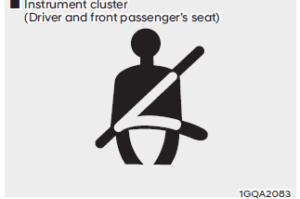
Driver’s and Passenger’s front seat belt warning
As a reminder, the seat belt warning light will illuminate for approximately 6 seconds each time you turn the ignition switch or ENGINE START/STOP button ON regardless of belt fastening. If the seatbelt is not fastened, the warning chime will sound for about 6 seconds. If you start to drive without the seat belt fastened over approximately 5 mph (9 km/h) and less than approximately 12 mph (20 km/h), the corresponding warning light will illuminate. The warning light will turn off when the vehicle speed drops below approximately 5 mph (9 km/h). If you start to drive without the seat belt fastened or you unfasten the seat belt when you drive approximately 12 mph (20 km/h) and faster, the warning light will blink and a warning chime will sound for approximately 100 seconds. When the seat belt is unfastened during driving, the warning light will illuminate when the speed is over approximately 5 mph (9 km/h) and less than approximately 12 mph (20 km/h). When the speed is approximately 12 mph (20 km/h) and faster, the warning light will blink and a warning chime will sound for approximately 100 seconds.
Seat Belt Restraint System
WARNING

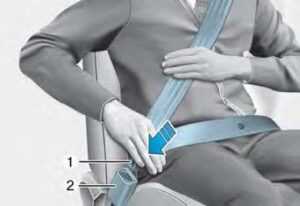
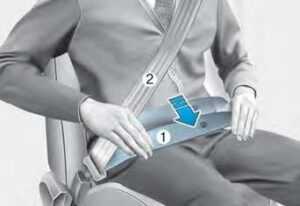


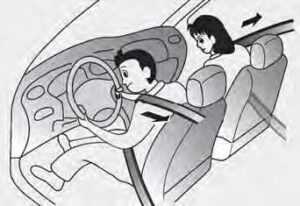

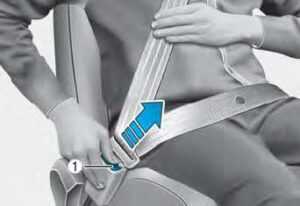
FAQ
You can typically find these guidelines in the owner’s manual provided with the vehicle or on the official Hyundai website.
The Safety Precautions section often provides essential safety information and guidelines for vehicle occupants.
Yes, the guide should include instructions for adjusting and wearing seat belts correctly.
The guide should offer instructions for properly securing child safety seats based on the child’s age and size.
Yes, it often includes recommendations for choosing safe seating positions for all occupants.
The guide should offer guidance on securing child passengers properly within child safety seats.
Yes, it should emphasize the importance of wearing seat belts for all occupants and in all seating positions.
The guide should provide information on how to interpret seat belt warning lights and what actions to take.
The guide may offer troubleshooting steps for addressing seat belt-related issues.
Yes, it typically includes tips for cleaning and maintaining seat belts for optimal safety.
The guide may offer recommendations for safely securing and transporting cargo to prevent injuries during sudden stops or accidents.
Yes, it should include information on the legal requirements for seat belt use in your specific region or country.
The guide may offer tips for safely transporting pets in the vehicle.
The guide may include contact information for Hyundai customer service or support for further assistance with seat belts or safety-related inquiries.
Yes, it often underscores the importance of seat belt use for all passengers, regardless of where they are seated in the vehicle.
Useful Link
View Full User Guide: Hyundai Kona 2023 User Guide
Download Manuals: https://owners.hyundaiusa.com/us/en/resources/manuals-warranties.html
2023 Hyundai KONA Specs, Price, Features, Milage (Brochure)

